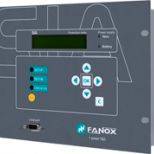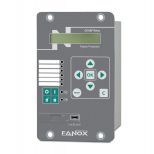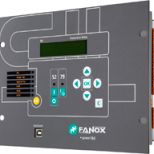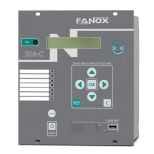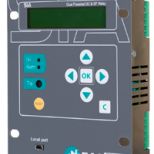Feeder protection relay for primary distribution
FANOX
SIL-C
- The SIL-C is a feeder relay with current, voltage, and frequency functions for primary and secondary distribution. Its auxiliary power supply is 24- 230 Vdc/ac.
- 4 current channels for conventional /1 and /5 current transformers and 5 voltage channels for conventional VTs.
- It is capable of measuring up to 1.000 volts when connected directly to the low-voltage line.
- Metal housing with a high electromagnetic compatibility level (EMC) and a wide range of operating temperature.
- Protection against decoupling, load shedding, and Loss of Main (islanding). Loss of Main (islanding) occurs when part of the public utility network loses connection with the rest of the system. In case this situation is not detected, a network safety hazard can be present if the generator remains connected since an automatic reconnection of the generator may occur, causing damage to the generator and the network. SIL-C relay detects this hazardous situation thanks to its voltage and frequency functions based on the Rate Of Change Of Frequency (ROCOF) method.
- Signaling/control of the circuit breaker (52 function) and the recloser (79 function).
- The front part of the SIL-c relays is provided with a navigation keypad made of 7 keys (including the RESET key), 6 programmable hot keys that are configured by default: two (2) keys to open and close the CB, two (2) keys to block and unblock the recloser and two (2) keys to put the relay in local or remote mode with their associated three (3) configurable control LEDs. Besides, eight (8) programmable alarm LEDs.
- In case a CB is manually closed, a switch on to an existing fault may occur. This fault condition is critical if the overcurrent protection function does not clear the fault until the adjusted time delay is fi In those cases, it is necessary to clear the fault quickly through the SOTF function.
- To allow the communication, the SIL-C relays are provided with a local micro-USB front port and remote communication options (ports and protocols) on the rear side:
- Rear Serial Port: Modbus RTU, DNP3.0 Serial or IEC60870-5-103 (selectable by general settings).
- Rear Ethernet Port (RJ45 or FO-LC): Modbus TCP/IP, DNP3.0 TCP/IP, IEC60870-5-104 or IEC61850 (selectable by general settings) + SNTP Protocol + Web Server.
- Wireless communication (Wi-Fi) and synchronization through IRIG-B are optional (depending on the model).
- Alarms panel is available.
- The SIL-C is provided with (depending on the model):
- 8 configurable inputs and 7 configurable outputs.
- 11 configurable inputs and 5 configurable outputs.
- The SIL-C is fitted with demand of power (LDP - Load Data Profiling) with the following characteristics:
- Number of records: 2160.
- Circular recording mode.
- Sampling rate (interval): configurable through communications (1-60 min).
- SIL-C is provided with non-volatile RAM memory in order to store up to 3072 events and the disturbance fault recording (DFR), maintaining date & time thanks to its internal RTC (Real Time Clock). The configurable options are:
- 5 records in data and COMTRADE format (300 cycles each record): 1 to 8 pre-fault cycles + 292 to 299 post-fault cycles.
- 25 records in data and COMTRADE format (60 cycles each record): 1 to 8 pre-fault cycles + 52 to 59 post-fault cycles.
- 50 records in data and COMTRADE format (30 cycles each record): 1 to 8 pre-fault cycles + 22 to 29 post-fault cycles.
- 100 records in data and COMTRADE format (15 cycles each record): 1 to 8 pre-fault cycles + 7 to 14 post-fault cycles.
- Each oscillographic record contains 10 analogue channels and up to 96 configurable digital channels. The oscillography is downloaded by a communications port. The SICom communications program allows the oscillography record to be downloaded and saved in COMTRADE format (IEEE C37.111-1991).
Ask for enquiry





